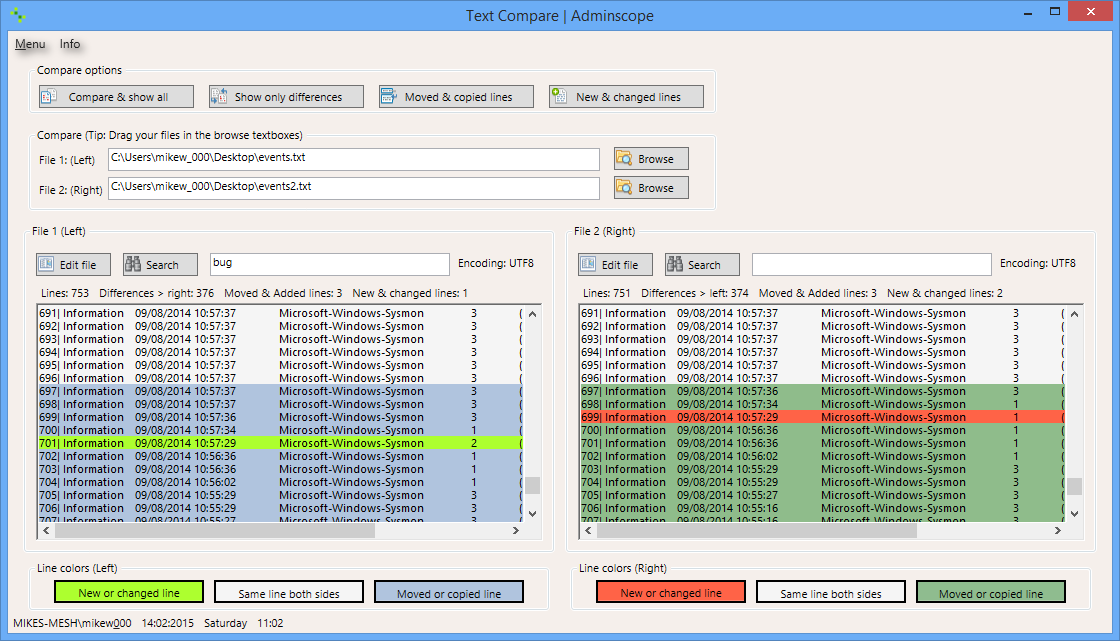

More distantly related pairs of species, for example, Plasmodium falciparum and P. The published databases already include 33 species for which at least one other closely related species has been sequenced for a detailed list see. Many of these involve species that are closely related to published genomes. As of mid-2003, there are more than 150 complete published genomes, with over 380 prokaryotic genome projects and 240 eukaryotic projects under way.
#COMPARE TEXT SOFTWARE#
The number of pairs of closely related genomes has increased dramatically in recent years, with a corresponding increase in the number of scientific studies of genome structure and evolution, facilitated by new software that permits the comparisons of these genomes.


#COMPARE TEXT LICENSE#
The first two releases of MUMmer had over 1,600 site licensees, a number that has grown since moving to an open-source license in May 2003. In response to this need, TIGR released MUMmer 1.0, the first system that could perform genome comparisons of this scale. The comparison also made it clear that a new type of bioinformatics program was needed, one that could efficiently compare two megabase-scale sequences, something that BLAST cannot do. Comparison of these genomes revealed an overall genomic structure that was very similar, but showed evidence of two large inversion events centered on the replication origin. With the publication of the second strain of Helicobacter pylori in 1999, following the publication of the first strain in 1997, the scientific world had its first chance to look at two complete bacterial genomes whose DNA sequences lined up very closely. Until 1999, each new genome published was so distant from all previous genomes that aligning them would not yield interesting results. In recent years, an important new sequence-analysis task has emerged: comparing an entire genome with another. The results of such protein and nucleotide database searches have been used in recent years as the basis for assigning function to most of the newly discovered genes emerging from genome projects. The most commonly used application of these sequence-analysis programs is for comparing a single gene (either a DNA sequence or the protein translation of that sequence) to a large database of other genes. The pairwise sequence-comparison methods implemented in BLAST and FASTA have proved invaluable in discovering the evolutionary relationships and functions of thousands of proteins from hundreds of different species. After doing that, click on the Compare button to compare two texts.Genome sequence comparison has been an important method for understanding gene function and genome evolution since the early days of gene sequencing.
#COMPARE TEXT HOW TO#
How to Use the Online Text Comparison ToolĬopy and paste your text to the inputs above. Instead of using MS Word or Google Docs, paste your text strings to instantly see the difference between them. Text Compare is a difference checker that allows you to compare two documents to find the difference. Click Compare to see the difference between the two text files.From the Tools menu, select Compare Documents.To compare text files using Google Docs, you can: How to compare text files using Google Docs Click OK to see the difference between the two text files.Select the Original document and Revised document.From the Tools menu, select Track Changes, then Compare Documents.Open one of the documents that you want to compare.To compare text files using Microsoft Word, you can: How to compare text files using Microsoft Word You can use Microsoft Word, Google Docs, or an online text comparison tool. There are numerous ways you can compare two text files.


 0 kommentar(er)
0 kommentar(er)
